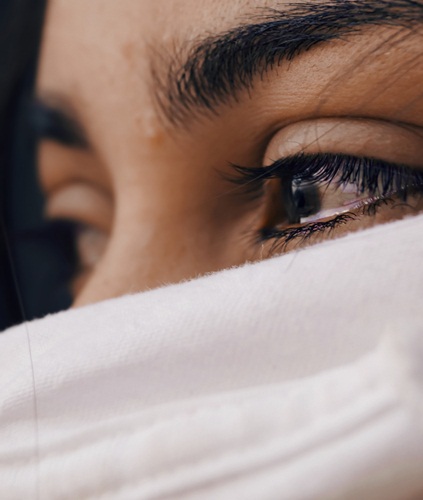Learning to love myself—my child self, my adult self, my scared self, the courageous self that I keep tucked away a lot of the time—has been the hardest part of my journey with trauma.
RICHARD ROHR OFM
Claude AnShin Thomas suffered for years from the trauma of war as a Vietnam combat veteran. A retreat with Buddhist teacher Thich Nhat Hanh set him on the path of mindfulness and healing. He is now a Zen Buddhist monk. He recounts his story:
I suffer from a disturbed sleep pattern that has been a part of my life since a nighttime attack in Vietnam in 1967. Since that time, I haven’t slept for more than two consecutive hours in any one night. . . . My sleeplessness became the central symbol of my not-all-rightness, of my deepest fears that I would never be all right. . . .
Part of the reason I had difficulty sleeping was because of my night terrors: the sounds of artillery (that isn’t there) firing in the distance, of helicopters on assault, that special look of everything illuminated by artificial light, the sounds of small arms fire, of the wounded screaming for a medic. For me, this is what rises up out of the silence that is special to night. I hated the sun going down. I fought and struggled with my inability to sleep, and the more I fought, the more difficult the nights became. So I turned to alcohol and drugs (legal and illegal) for relief, but my suffering just got worse. . . .
Some years after getting sober, I was standing at the kitchen sink in my cottage in Concord, washing dishes. Above the sink was a window through which I could see a row of fifty-foot-tall pine trees that lined the driveway. That day as I did the dishes, I was watching a squirrel busy doing whatever it is that squirrels do, when I had a powerful experience. A voice inside me, the voice of awareness, said to me, “You can’t sleep, so now what?” I began to laugh. It was a moment of complete acceptance. I finally understood that I just was how I was. To resist, to fight, to attempt to alter the essential nature of my life, was in fact making matters worse, and now I understood that I simply needed to learn how to live with the reality of who I was. In this moment I discovered that it was here, in the midst of suffering and confusion, that healing and transformation can take place, if I can stop trying to escape.
But I’m not special, you know. You can do this, too. You can face your own sorrow, your own wounds. You can stop wanting some other life, some other past, some other reality. You can stop fighting against the truth of yourself and, breathing in and breathing out, open to your own experience. You can just feel whatever is there, exploring it, until you also discover the liberation that comes with stopping the struggle and becoming fully present in your own life. This is the real path to peace and freedom. You could do this for yourself; you could do this for your family. Our whole world will benefit.
The Soul Wound
Attorney and activist Sherri Mitchell from the Penobscot Nation writes about the collective trauma and “soul wound” that Native Americans have suffered:
My group, Native Americans, have suffered an unrecognized holocaust in this country. The brutal genocide of Native peoples is hard to acknowledge for many, especially for those who have inherited some value from the loss and destruction that occurred here. How do you acknowledge the injustice of genocide, disruption of culture, and the destruction of a way of life when you’re living on the lands of those who have been victimized? It is hard for people to accept that horror and continue to live with the outcome, so they choose to ignore it or minimize the story. The simple truth is that this country was founded on genocide and slavery. . . .
When we don’t allow ourselves to acknowledge the pain—the deep, agonizing soul pain that results from historical trauma—we aren’t able to recognize that we are all carrying some measure of that pain within us. Instead, we allow it to isolate us and keep us cut off from one another. We also fail to recognize that the cause of that pain is not only a violation against us, it is a violation against life itself, and its mournful cries echo through our DNA, and become lodged in our genetic memory.
The collective and intergenerational trauma that Sherri Mitchell describes manifests in individual bodies and requires healing on multiple levels. Kaitlin Curtice, a dear personal friend and member of the Potawatomi Nation, shares:
I am someone who journeys with trauma.
The next step after naming my trauma—the trauma of assimilation, the trauma of being an Indigenous woman who grew up in the Baptist church, the trauma of a broken family, the trauma of struggling with anxiety, and more—was to learn how to live with the reality of those traumas, because once we name something out loud, it becomes true in a way it wasn’t before. My journey with trauma includes learning to love myself in a more embodied way, continuing therapy, and actually stepping out of toxic church spaces and institutions into a fuller journey with the Christian faith that accepts me as I am.
Learning to love myself—my child self, my adult self, my scared self, the courageous self that I keep tucked away a lot of the time—has been the hardest part of my journey with trauma. When we learn to stop blaming our child selves for their trauma, fear, and behaviors, we learn to understand who we are as adults, and we get the chance to become embodied again.
∎